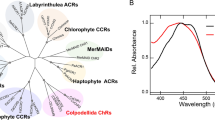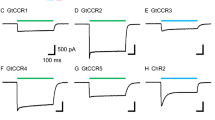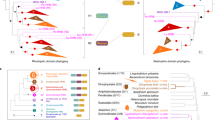Abstract
Rhodopsin is a visual pigment ubiquitous in multicellular animals. If visual pigments have a common ancient origin, as is believed, then some unicellular organisms might also use a rhodopsin photoreceptor1,2. We show here that the unicellular alga Chlamydomonas does indeed use a rhodopsin photoreceptor. We incorporated analogues of its retinal chromophore into a blind mutant; normal photobehaviour was restored and the colour of maximum sensitivity was shifted in a manner consistent with the nature of the retinal analogue added. The data suggest that 11-cis-retinal is the natural chromophore and that the protein environment of this retinal is similar to that found in bovine rhodopsin, suggesting homology with the rhodopsins of higher organisms. This is the first demonstration of a rhodopsin photoreceptor in an alga or eukaryotic protist and also the first report of behavioural spectral shifts caused by exogenous synthetic retinals in a eukaryote. A survey of the morphology and action spectra of other protists suggests that rhodopsins may be common photoreceptors of chlorophycean, prasinophycean and dinophycean algae. Thus, Chlamydomonas represents a useful new model for studying photoreceptor cells.
This is a preview of subscription content, access via your institution
Access options
Subscribe to this journal
Receive 51 print issues and online access
$199.00 per year
only $3.90 per issue
Buy this article
- Purchase on Springer Link
- Instant access to full article PDF
Prices may be subject to local taxes which are calculated during checkout
Similar content being viewed by others
References
Foster, K. W. & Smyth, R. D. Fedn Proc. 39, 2139 (1980).
Foster, K. W. & Smyth, R. D. Microbiol. Rev. 44, 572–630 (1980).
Ehrenberg, C. G. Die Infusionthierchen als Vollkommene Organismen, Leipzig (1838).
Song, P.-S. Photochem. Photobiol. Rev. 7, 77–140 (1983).
Greuet, C. Année biol. 21, 97–141 (1982).
Balogh-Nair, V. & Nakanishi, K. in New Comprehensive Biochemistry Vol. 3 (ed. Tamm, Ch.) (Eisevier, Amsterdam, 1982).
Balogh-Nair, V. & Nakanishi, K. Meth. Enzym. 88, 496–506 (1982).
Kropf, A., Whittenberger, B. P., Goff, S. P. & Waggoner, A. S. Expl Eye Res. 17, 591–606 (1973).
Motto, M. G., Sheves, M., Tsujimoto, K., Balogh-Nair, V. & Nakanishi, K. J. Am. chem. Soc. 102, 7947–7949 (1980).
Schimz, A., Sperling, W., Ermann, P., Bestmann, H. J. & Hildebrand, E. Photochem. Photobiol. 38, 417–423 (1983).
Schimz, A., Sperling, W., Hildebrand, E. & Kohler-Hahn, D. Photochem. Photobiol. 36, 193–196 (1982).
Otto, M. K., Jayaram, M., Hamilton, R. M. & Delbruck, M. Proc. natn. Acad. Sci. U.S.A. 78, 266–269 (1981).
Wang, W.-Y. Genetics 91, s134 (1979).
Knowles, A. & Dartnell, H. J. in The Eye Vol. 2B (ed. Davson, H.) 76 (Academic, New York, 1977).
Nakanishi, K., Balogh-Nair, V., Arnaboldi, M., Tsujimoto, K. & Honig, B. J. Am. chem. Soc. 102, 7945–7947 (1980).
Oesterhelt, D. & Stoekenius, W. Nature new Biol. 233, 149–152 (1971).
Huang, B., Ramanis, Z., Dutcher, S. K. & Luck, D. J. C. Cell 29, 745–753 (1982).
Straley, S. C. & Bruce, V. G. Pl. Physiol. 63, 1175–1181 (1979).
Goodenough, J. E., Bruce, V. G. & Carter, A. Biol. Bull. mar. biol. Lab., Woods Hole 161, 371–381 (1981).
Hoops, H. J. & Witman, G. B. J. Cell Biol. 97, 902–908 (1983).
Brokaw, C. J. & Luck, D. J. C. Cell Motility 4, 131–150 (1983).
Nathans, J. & Hogness, D. S. Cell 34, 807–814 (1983).
Nichelson-Guthrie, C. S. & Hudock, G. A. J. gen. Microbiol. 129, 159–165 (1983).
Hutner, S. H., Provosoli, L., Schatz, A. & Haskins, C. P. Proc. Am. phil Soc. 94, 152–170 (1950).
Eslava, A. P., Alvarez, M. I. & Cerdá-Olmedo, E. Eur. J. Biochem. 48, 617–623 (1974).
Hubbard, R., Brown, P. K. & Bownds, D. Meth. Enzym. 33 C, 615–653 (1971).
Arnaboldi, M., Motto, M. G., Tsujimoto, K., Balogh-Nair, V. & Nakanishi, K. J. Am. chem. Soc. 101, 7082–7086 (1979).
Blatz, P. E., Dewhurst, P. B., Balasubramaniyan, V., Balasubramaniyan, P. & Lin, M. Photochem. Photobiol. 11, 1–15 (1970).
Erickson, J. O. & Blatz, P. E. Vision Res. 8, 1367–1375 (1968).
Tokunaga, F. & Ebrey, T. G. Biochemistry 17, 1915–1922 (1978).
Sperling, W. & Schimz, A. Biophys. Struct. Mech. 6, 165–169 (1980).
Azuma, M., Azuma, K. & Keto, Y. Biochim. biophys. Acta 295, 520–527 (1973).
Honig, B. et al. J. Am. chem. Soc. 101, 7084–7086 (1979).
Schletz, K. Z. Pflanzenphysiol 77, 189–211 (1976).
Litvin, F. F., Sineshchekov, O. A. & Sineshchekov, V. A. Nature 271, 476–478 (1978).
Halldal, P. Physiologia Pl. 14, 133–139 (1961).
Forward, R. B. Jr J. Protozool. 21, 312–315 (1974).
Lack, D. J. L. J. Cell Biol. 98, 789–794 (1984).
Author information
Authors and Affiliations
Rights and permissions
About this article
Cite this article
Foster, K., Saranak, J., Patel, N. et al. A rhodopsin is the functional photoreceptor for phototaxis in the unicellular eukaryote Chlamydomonas. Nature 311, 756–759 (1984). https://doi.org/10.1038/311756a0
Received:
Accepted:
Issue Date:
DOI: https://doi.org/10.1038/311756a0
This article is cited by
-
Cells collectively migrate during ammonium chemotaxis in Chlamydomonas reinhardtii
Scientific Reports (2023)
-
Three Families of Channelrhodopsins and Their Use in Optogenetics (review)
Neuroscience and Behavioral Physiology (2019)
-
Adhesion of Chlamydomonas microalgae to surfaces is switchable by light
Nature Physics (2018)
-
Ubiquitous distribution of helmchrome in phototactic swarmers of the stramenopiles
Protoplasma (2016)
Comments
By submitting a comment you agree to abide by our Terms and Community Guidelines. If you find something abusive or that does not comply with our terms or guidelines please flag it as inappropriate.



